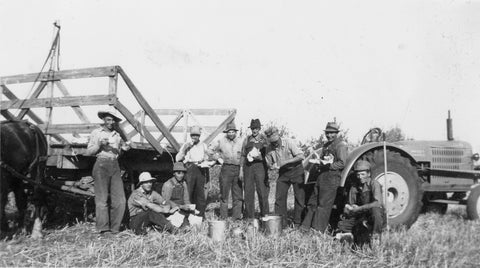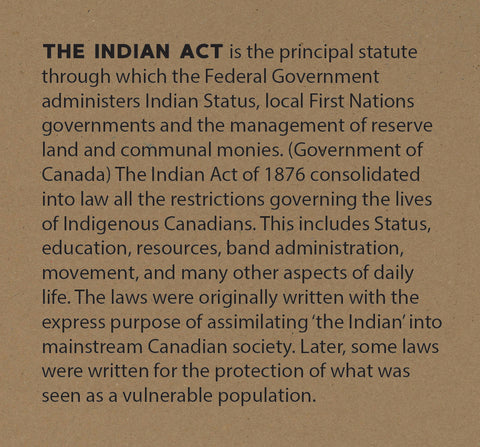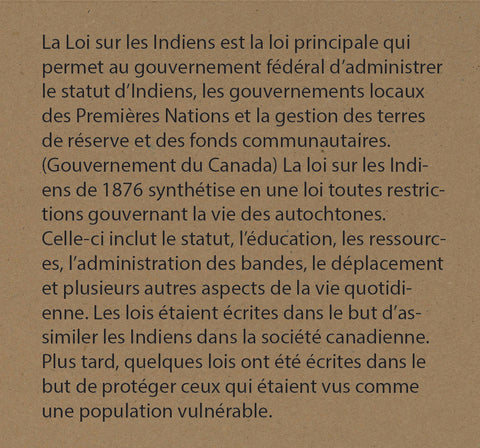


ONLINE EXHIBITION
A Reputation for Hard Work
By the turn of the century, the members of Michel Band were recognized by the Department of Indian Affairs and by their neighbours as being very hard-working, self-supporting people.
“Michel’s Band …These are Iroquois Indians… They number eighty-five souls…this is the banner reserve of the agency…These Iroquois Indians or rather half-breeds as they are now, came about 100 years ago from Lower Canada, and are a very superior class of Indians. About fifty-five of them, eight families, live and work on the reserve, and are making a good living by mixed farming, selling their grain, cattle, pork, in Edmonton or St. Albert, besides getting a considerable amount of money from the sale of dead timber, killed by the fire that swept the country some four years ago. Their buildings- in fact the whole reserve – compare favourably with any white settlement. Many of the houses are well furnished, with good furniture, to which recently a $120 organ was added. Their stock number about ninety-five head and are always well cared for and stabled, the cows being carefully milked, and butter made regularly.” – James Gibbons, Annual Report to the Secretary General of Indian Affairs, 1900.
“The members of this band may be said to be self-supporting, as they get, I may say, no help from the government. ….All belong to the Roman Catholic Church and they attend regularly. Their children attend the St. Albert boarding school; the parents are anxious that their children be educated.” – James Gibbons, Annual Report to the Secretary General of Indian Affairs, 1902.
At the time, the Indian Department, as it was known, was tightening control of all aspects of Indigenous peoples lives. Things began to change. In a way, Michel Band’s success left them open to interference by the government. Even as they prospered, various powers were working to restrict the movement and progress of First Nations persons across Canada. Various Indian Agents had differing views on how much freedom a group of “Indians under their care” could handle.
Image Credits: Threshing Crew, Courtesy of Celina Loyer/L’équipe de battage. Courtoisie de Celina Loyer
Au tournant du siècle, les membres de la bande Michel étaient reconnus par le ministère des Affaires indiennes et par leurs voisins comme des travailleurs acharnés et des personnes autosuffisantes.
« La bande Michel… Ce sont des Indiens iroquois… On y compte quatre-vingt-cinq âmes… c’est la réserve modèle de l’agence… Ces Indiens iroquois ou plutôt Métis maintenant, sont arrivés du Bas-Canada il y a environ 100 ans et ils sont d’une classe supérieure d’Indiens. Environ cinquante-cinq d’entre eux, huit familles, vivent et travaillent dans la réserve. Ils gagnent bien leur vie avec l’agriculture mixte et la vente de grain, de bétail et de porc à Edmonton ou à Saint-Albert. De plus, ils reçoivent un montant important d’argent de la vente de bois mort, tué par les feux qui ont assailli le pays il y a près de quatre ans passés. Leurs bâtiments, en fait toute leur réserve, se comparent favorablement à n’importe quelle colonie d’hommes blancs. La plupart des maisons sont bien meublées avec de beaux meubles et un orgue de 120$ a récemment été ajouté. Le bétail est toujours bien soigné et logé, on y compte environ quatre-vingt-quinze têtes. On trait les vaches avec soin et le beurre est fait régulièrement. » – James Gibbons, Rapport annuel au Secrétaire général des Affaires indiennes, 1900.
« Il est dit que les membres de cette bande sont aussi autosuffisants qu’on peut l’être, je précise, aucun appui du gouvernement… Chaque membre appartient à l’Église catholique romaine et y assiste régulièrement. Leurs enfants vont au pensionnat de Saint-Albert; les parents s’impatientent, désireux d’une éducation pour leurs enfants. » – James Gibbons à Frank Oliver, Surintendant général aux Affaires indiennes, 1902.
À l’époque, le ministère des Affaires indiennes resserrait le contrôle sur tous les aspects de la vie des personnes autochtones. Les choses commençaient à changer. D’une manière, le succès de la bande Michel a ouvert la porte à l’intrusion du gouvernement. Même lorsqu’ils prospéraient, plusieurs forces travaillaient pour restreindre le mouvement et le progrès des Premières Nations partout au Canada. Plusieurs des agents des Affaires indiennes avaient différents points de vue sur le montant de liberté que pouvait gérer un groupe « d’Indiens sous leur charge ».


